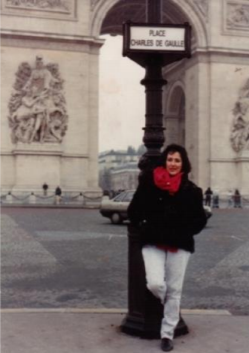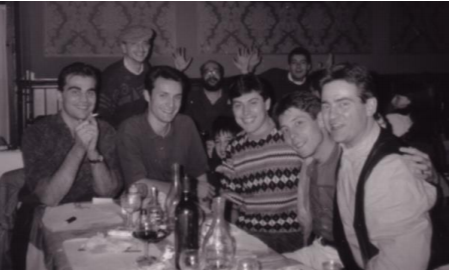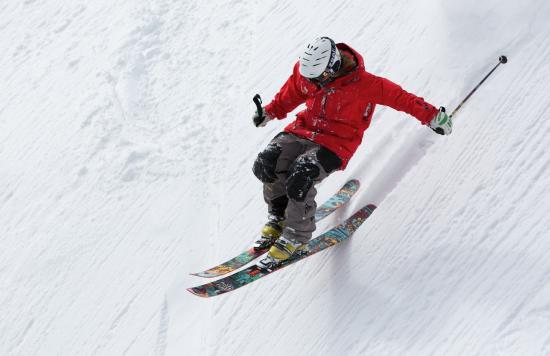5.5: Qu'est-ce qu'on vient de faire ? Qu'est-ce qu'on est en train de faire ?
- Page ID
- 118705
In this section, you will learn how to:
- Talk about things you "just did" with the passé récent with venir de...
- Talk about actions in progress with être en train de...
Listen to the audio clips that follow on this page to hear the French pronunciation of vocabulary and examples presented.
On étudie !
Le passé récent avec « venir de »
Here are 3 examples of sentences in which we use venir de to talk about things that just happened.
To practice, watch the video and repeat.
| Français | Anglais |
|---|---|
| venir de + infinitif venir de (faire quelque chose) |
to have just + past tense to have just (done something) |
| Je viens de manger. | I just ate. |
| Elle vient d'arriver. | She just arrived. |
| Nous venons de voir un film. | We just saw a movie. |
Pour en savoir plus.
Let's talk more about our daily neighborhood activities.
| Français | Anglais |
|---|---|
| quartier | neighborhood |
| se faire couper les cheveux | to get a haircut |
| faire réparer les chaussures | to get shoes repaired |
| faire nettoyer un vêtement | to get an item of clothing cleaned |
| acheter un album de Stromae | to buy an album by Stromae |
| garer la voiture | to park the car |
| se faire faire les ongles | to get nails done |
| observer les gens | watch people |
| faire du lèche-vitrine | to window shop |
| dépenser de l’argent | to spend money |
| déposer de l’argent | to deposit money |
| retirer de l’argent | to withdraw money |
Study the Quizlet vocabulary flashcards. Listen and repeat the French pronunciation.
Actions en cours avec « être en train de faire »
Structure : être en train de + infinitif
| Français | Anglais |
|---|---|
| être en train de + infinitif être en train de (faire quelque chose) |
to be in the middle, process of + present participle (-ing) to be in the middle, process of (doing something) |
| Je suis en train de parler. | I am (in the middle of) talking. |
| Vous êtes en train de manger. | You are (in the process of) eating. |
| Ils sont en train d'étudier. | They are studying right now, in this moment. |
Pour en savoir plus.
On pratique !
Activité A
Devinez. À tour de rôle avec un(e) partenaire, devinez (guess) ce que Guillaume et ses amis viennent de faire.
Modèle :
Guillaume n’est pas à la maison. ➔ Il vient de sortir.
- Marie a l’air contente.
- Jacques n’a pas soif.
- Lucas prend une douche.
- Hugo n’a pas d’argent.
- Martin débarrasse la table.
- Tiana est très fatiguée.
Activité B
Qu’est-ce qu’ils viennent de faire ? Trouvez trois photos avec des personnes. Écrivez ce que vous pensez qu'ils viennent de faire. Demandez ensuite à vos camarades de classe de deviner ce qu'ils viennent de faire.
Modèle :
| Elle vient de visiter l’Arc de Triomphe à Paris. | Ils viennent de dîner au restaurant. |
|---|---|
|
"Arc de triomphe" by William J Carrasco is licensed under CC BY 4.0 |
"Dîner avec Williams" by William J Carrasco is licensed under CC BY 4.0 |
Activité C
Avec un(e) partenaire, dites ce que vous venez de faire et ce que vous allez faire ensuite.
Modèle :
(a) Je viens de manger un poulet rôti. Maintenant je vais prendre un dessert.
(b) Je viens de finir le semestre d’anglais. Je vais partir en vacances.
Activité D
Depuis combien de temps ? Répondez aux questions suivantes :
Modèle :
Étudiant(e) 1 : Depuis combien de temps est-ce que tu étudies à Palomar College ? ➔
Étudiant(e) 2 : J’étudie à Palomar College depuis un an. Je viens de commencer mes études à Palomar.
- Depuis combien d’heures est-ce que tu travailles ?
- Depuis quand prends-tu des cours à Palomar College ?
- Tu attends le médecin depuis combien de temps ?
- Depuis quand habites-tu chez toi ?
- Depuis quand est-ce que tu aimes la langue française ?
- Depuis quand as-tu un permis de conduire (driver’s license) ?
Activité E
Qu'est-ce qu'on vient de faire en ville ?
Utilisez les éléments proposés pour transformer les phrases au passé récent (venir de/d' + infinitif) en suivant le modèle.
Modèle : au centre commercial / Marielle / faire des achats ➔ Au centre commercial, Marielle vient de faire des achats.
- (à la poste, mon père, envoyer une lettre) ➔________.
- (au restaurant, les clients, dîner) ➔________.
- (à la piscine, tu, nager) ➔________.
- (à la gare, un étudiant international, prendre un train) ➔________.
- (au cinéma, je, voir un film) ➔________.
- (au théâtre, nous, voir une pièce) ➔________.
- (à la bibliothèque, vous, emprunter des livres) ➔________.
- (à la banque, les salariés, déposer de l'argent) ➔________.
- (au stade, on, voir un match de foot) ➔________.
- (à Paris, les touristes, visiter les musées) ➔________.
- (à San Diego, cette famille, aller au zoo) ➔________.
Activité F
Qu’est-ce qu’ils sont en train de faire ?
|
|
|
|
| 1. Nous ________ . | 2. Tu ________ . | 3. Je ________ . |
|
|
|
|
| 4. Il ________ . | 5. Elle ________ . | 6. Il ________ . |
On approfondit !
Use the following resources to type accents and/or search for words:
- Accents: ç, à, é, è, â, ê, î, ô, û, ù, ë, ï, ü
- Dictionnaire français-anglais









